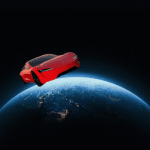 Humans
Humans  Humans
Humans  Animals
Animals 10 Animals That Humiliated and Harmed Historical Leaders
 History
History 10 Most Influential Protests in Modern History
 Creepy
Creepy 10 More Representations of Death from Myth, Legend, and Folktale
 Technology
Technology 10 Scientific Breakthroughs of 2025 That’ll Change Everything
 Our World
Our World 10 Ways Icelandic Culture Makes Other Countries Look Boring
 Misconceptions
Misconceptions 10 Common Misconceptions About the Victorian Era
 Mysteries
Mysteries 10 Strange Unexplained Mysteries of 2025
 Miscellaneous
Miscellaneous 10 of History’s Most Bell-Ringing Finishing Moves
 History
History 10 Great Escapes That Ended Right Back in Captivity
 Humans
Humans 10 Everyday Human Behaviors That Are Actually Survival Instincts
 Animals
Animals 10 Animals That Humiliated and Harmed Historical Leaders
 History
History 10 Most Influential Protests in Modern History
Who's Behind Listverse?

Jamie Frater
Head Editor
Jamie founded Listverse due to an insatiable desire to share fascinating, obscure, and bizarre facts. He has been a guest speaker on numerous national radio and television stations and is a five time published author.
More About Us Creepy
Creepy 10 More Representations of Death from Myth, Legend, and Folktale
 Technology
Technology 10 Scientific Breakthroughs of 2025 That’ll Change Everything
 Our World
Our World 10 Ways Icelandic Culture Makes Other Countries Look Boring
 Misconceptions
Misconceptions 10 Common Misconceptions About the Victorian Era
 Mysteries
Mysteries 10 Strange Unexplained Mysteries of 2025
 Miscellaneous
Miscellaneous 10 of History’s Most Bell-Ringing Finishing Moves
 History
History 10 Great Escapes That Ended Right Back in Captivity
10 Awesome Upgrades to Common Household Items
Every item in the future will probably be “smart,” even if the individuals using these items may not match that trend.
This is generally a good thing, because improved designs and added technology can help us all lead healthier, happier lives. Accordingly, the following breakthroughs promise to take everyday household conveniences to the next level, with features so advanced they make The Jetsons look like The Flintstones.
Related: 10 Miraculous Advances Toward Curing Incurable Diseases
10 Video Games with “Living” NPCs Powered by Chatbot-Like AI
Gamers know that few things are as immersion-breaking as dumb NPCs. Whether walking into walls or repeating the same old entreaty to go fishing while the world around them literally burns, NPCs often leave a lot to be desired.
Now, NVIDIA’s ACE promises to breathe unprecedented vitality into these lifeless characters. The technology comprises a “suite of digital human technologies” to boost video game NPCs and digital assistants via AI integration.
In a possible wave of the future that may find itself in many games—maybe all games—imbuing chatbot-like AI could create more realistic, immersive virtual worlds.
These worlds would be populated with characters that dynamically perceive and respond to in-game environments and players’ actions in real time, powered by human-like memories, emotions, and unpredictable strategic abilities that constantly evolve with each player-made choice.
And with the possibility to ostensibly make every video game feel like you’re playing Club Penguin, but with swords and dragons, this is one mouth-watering digital upgrade.[1]
9 Smart Contacts That Diagnose Disease
Pop science has promised us contact lenses that zoom in, offer night vision, and let us watch Gone in 60 Seconds right on our eyeballs. What’s even more essential may be contact lenses that keep people from losing their vision.
Glaucoma, for example, is one of the world’s leading causes of vision loss, affecting more than 60 million individuals. Glaucoma involves increased pressure inside the eye, gradually damaging the (nonregenerating) optic nerve that connects the eye and the brain.
However, some newly developed smart contacts use sensors to track eye pressure, allowing early detection and treatment of glaucoma. These are “theranostic” devices that both diagnose and treat the condition because the lenses themselves can deliver relieving medication when they detect high inside-the-eye (intraocular) pressure.[2]
8 Bone-Strengthening Space Lettuce
Food advances for space can have big implications here, down in non-space*. For example, astronauts lose lots of bone mass in microgravity, and lettuce may be the answer. Or other genetically modified veggies, with practicality that could reach all the way down to Earth.
So while this advanced super-lettuce was created for lettuce-starved spacefarers, a lot of the advancements we enjoy today are owed to space science, including the oh-so-comfortable memory foam that shapes itself to your ample curves.
Such innovations in culinary science could help make us all healthier. The transgenic (genetically modified) lettuce could replace the astronauts’ need to inject parathyroid hormone (PTH), which helps rebuild bone mass in space.
The ultimate goal is to save weight by eschewing the medicine and carrying the modified seeds, producing plants that create edible drugs. Alternatively, the drugs can be sourced from the plants, if they aren’t bioavailable in their edible form.
Colloquially speaking, of course, because every single thing is in space.[3]
7 Sunscreen That Cools You Down
Sunscreen blocks the Sun’s potentially harmful ultraviolet (UV) rays. It doesn’t cool you down, however, or not much. This is a sensible complaint because heat is also transferred in the form of rays, but in infrared instead of UV.
For people who run hot, or populations with sweltering temperatures, researchers developed a sunscreen that cools you down while keeping you safe from UV radiation.
It uses a tiny “nano” formulation of titanium dioxide to reflect both heat and UV radiation. As a result, it provides an SPF of around 50, resists water, and is effective for about 12 hours ( in xenon lamp simulations).
When slathered on real people in hot, humid environs, it cooled them by up to 11 degrees more than the sunscreens currently on the market. It’s also cheap to make—on par with commercially available options.[4]
6 A Magic Mattress and Pillow That Trick Your Body Into Sleep
Circadian rhythms control how we feel and whether we’re alert for that meeting or nodding off in front of the boss. So science has created various ways to improve shut-eye, like sleeping pills and YouTube videos—but what if your bed could help you doze off?
Accordingly, scientists are exploring a temperature-shifting bed and pillow. In addition to the comfort of a cool mattress, it tricks your body into sleep because body temperature naturally declines at night. Scientists say the neck area is like your body’s built-in thermostat, so the pillow warms up, tricking your body into thinking it’s warmer than it is.
Simultaneously, the mattress cools down the central areas of your body while heating the hands and feet—this hot-cold approach initiates blood flow to cause the dissipation of heat. When scientists tested their invention on 11 sleepers, who were asked to hit the blankets two hours before their regular bedtime, the results were promising. Those with the science-studded mattress fell asleep 58 percent faster and slept more soundly.[5]
5 Smart Clothing to Track Your Every Move
All the objects around us are getting fancy new features and becoming “smart.” But, lamentably, our clothes remain dumb. Perhaps not for long, though, because researchers at ETH Zurich are making smart textiles that can be turned into t-shirts, gloves, or, theoretically, a nice pair of undies.
Called SonoTextiles, the other major innovation here is that they aren’t using electronics, like previous developments in this area. Instead, they use “acoustic waves passed through glass [fibers].”
The fibers are interwoven in the shirt or what have you, with one end having a transmitter that generates sound waves and the other equipped with a receiver that analyzes how the sound waves are altered while traveling through the shirt.
As a result, smart apparel could reveal every movement you make, possibly in a sports-related environment, to boost your skills. Or in a medical environment to track someone’s vitals. Want better posture? Smart shirt! Alternatively, gloves made like this could translate hand movements into speech or text, or allow you to virtually control your computer or favorite game.[6]
4 A Health-Monitoring Sanitary Pad
Researchers at ETH Zurich don’t just want to change what you wear on the outside—they also want to change what’s under your clothes—to yield life-saving results.
Introducing “MenstruAI,” a higher-tech “sanitary towel” that you wear and then photograph. Also known as a pad, it features a non-electronic sensor allowing users to quickly and effortlessly track their wellness. The study author says, “To date, menstrual blood has been regarded as waste. We are showing that it is a valuable source of information,” and this can be used to help prevent adverse health issues.
By tracking various biomarkers, such as proteins, this new device can offer early warnings for significant developing issues like cancers, endometriosis, and general inflammation.
All a user would have to do is wear it, then take a picture. The embedded test strip—like a COVID test strip but for blood—would display color changes based on the presence of certain biomarkers. The color changes can then be analyzed via the naked eye or, more precisely, through an app.[7]
3 A Stress-Detecting Dental Flosser
Chronic stress can lead to chronic health conditions that weaken your heart and mind—literally and figuratively. Therefore, scientists have created a way to doubly boost your health, via a stress-detecting dental flosser that would let you gauge your stress levels in the comfort of your own abode. And we could all stand to floss more.
Generally, stress-testing would involve blood samples or questionnaires. But the first is inconvenient, and the second may be unreliable. The dental flosser can measure stress levels—and avoid the stress increases that accompany conventional tests—by simply collecting a bit of your spit. It then checks for cortisol levels, a common and major hormone that’s also associated with stress.
In testing, the device works exceptionally well and can detect the small cortisol spikes linked to rising stress levels. All while protecting your gingival health and helping you achieve fresher breath.[8]
2 The Environmentally Friendly, Non-Bruising Super-Banana
None of the produce we eat is “natural” because every fruit and veggie has been changed drastically from its wild form over the past millennia. So, with modern science, let’s engineer the heck out of them even more to feed the world.
To help achieve just that, biotech company Tropic is releasing a non-browning banana! It can resist bruising and browning during harvest and transport. Plus, it stays yellow, fresh, and banana-licious for 12 hours after peeling.
This super-banana could reverse a sad statistic: according to some estimates, 50% of bananas that are grown are never eaten, and 33 percent of all produce is dumped. Britain alone may throw away more than a million bananas every day.
On a global scale, this is a missed opportunity to feed people and a significant source of greenhouse gas emissions.[9]
1 Living Lenses Made of Bacteria
Lenses were a major, meticulous scientific achievement that required carefully shaping and polishing glass. Recently, University of Rochester scientists innovated a much more complex yet simpler and cheaper way to make tiny little lenses… living lenses made of bacteria.
Yes, using bacteria and enzymes (proteins that react with things) from sea sponges, researchers have created bacterial micro-factories, or self-growing lenses that are much less finicky in their manufacture. Micro-lenses can be the size of a single cell, and they previously required expensive machinery and crazy conditions to create—but now that machinery comes courtesy of, basically, SpongeBob.
Why sea sponges? Because they naturally make glass. In fact, they have glass skeletons crafted from minerals and sand. Plus, since the lenses are made by bacteria, these optical devices are alive and can remain so for months.
Such living lenses could improve medical imaging technologies to reveal molecule-sized objects, allowing researchers to see the structures, such as organelles, inside cells.[10]








